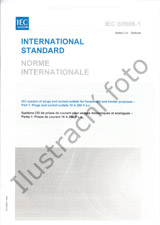Potřebujeme váš souhlas k využití jednotlivých dat, aby se vám mimo jiné mohly ukazovat informace týkající se vašich zájmů. Souhlas udělíte kliknutím na tlačítko „OK“.

IEC 61970-401-ed.1.0
Energy management system application program interface (EMS-API) - Part 401: Profile framework
Přeložit název
NORMA vydána dne 30.5.2022
Informace o normě:
Označení normy: IEC 61970-401-ed.1.0
Datum vydání normy: 30.5.2022
Kód zboží: NS-1064297
Přibližná hmotnost: 300 g (0.66 liber)
Země: Mezinárodní technická norma
Kategorie: Technické normy IEC
Kategorie - podobné normy:
Anotace textu normy IEC 61970-401-ed.1.0 :
IEC 61970-401:2022 describes how IEC 61970-450 (all parts), IEC 61970-600 (all parts) profile specifications are structured and created. Profile specifications describe a subset of the Canonical CIM dedicated to a specific data exchange. The Canonical CIM is described in IEC 61970 300 (all parts) as well as in IEC 61968-11. Rules for creation or extension of Canonical CIM are outside the scope of this document. This document specifies the structure of a profile specification and the rules for selecting subsets of information from the Canonical CIM. It standardizes the operations used to create the profile elements from the Canonical CIM. As Canonical CIM is described in UML the operations are described in terms of UML classes, attributes, and roles. It is possible to map UML to RDFS or OWL, so any of the languages UML, RDFS or OWL can be used to describe the created profiles. Specification of languages (UML, RDFS or OWL) used to describe profiles as well as how profiles are presented and edited in user interfaces are outside the scope of this document. Languages used to describe profiles are specified in other specifications. Relevant specifications are referenced in Clause 2. UML supports adding free text that describes further restrictions on UML constructs, e.g. classes, attribute values, association roles and cardinalities. Languages such as OCL and SHACL are dedicated to describing constraints. OCL is used to describe constraints for object data described in UML while SHACL is used to describe constraints on graph data described by RDFS or OWL. OCL is within the scope of this document, but SHACL is not. This document supports profiles describing data exchanged as CIMXML datasets or messages. The exchange format within the scope is in accordance with IEC 61970-552 but other formats are possible. Tool interoperability and serialisation formats are outside the scope of this document. This first edition cancels and replaces IEC TS IEC 61970-401 published in 2005. This edition constitutes a technical revision. This edition includes the following significant technical changes with respect to the previous edition: a) The previous edition of IEC TS 61970-401:2005 provided an overview of the Component Interface Specifications (CIS) IEC 61970-402, IEC 61970-403, IEC 61970-404, IEC 61970-405, and IEC 61970-407. IEC 61970-402 to IEC 61970-407 are duplicates of existing OPC interfaces from OPC Foundation and the DAIS/HDA interfaces from OMG. Hence IEC 61970-402 to IEC 61970-407 have been withdrawn and IEC TS 61970-401:2005 no longer serves a purpose. b) IEC 61970-401 (this document) does not contain an overview of Component Interface Specifications (CIS) but instead a description of how to create profile specifications that describes dataset contents (or message contents). Hence it has been renamed "Profile framework". The profile specifications IEC 61970-450 (all parts) and IEC 61970-600 (all parts) describe dataset contents. The purpose of this document is to define the rules to be followed in the process of creating profile specifications. IEC 61970-401:2022 decrit le mode de structuration et de creation des specifications de profils IEC 61970-450 (toutes les parties) et IEC 61970-600 (toutes les parties). Les specifications de profils decrivent un sous-ensemble du CIM canonique dedie a un echange de donnees specifiques. Le CIM canonique est decrit dans l’IEC 61970-300 (toutes les parties), ainsi que dans l’IEC 61968-11. Les regles de creation ou d’extension du CIM canonique ne relevent pas du domaine d’application du present document. Le present document definit la structure d’une specification de profil, ainsi que les regles de selection des sous-ensembles d’informations a partir du CIM canonique. Il normalise les operations qui permettent de creer les elements de profils a partir du CIM canonique. Etant donne que le CIM canonique est decrit en langage UML, les operations sont decrites en matiere de classes, dattributs et de roles UML. Du fait d’une mise en correspondance possible entre le langage UML et le langage RDFS ou OWL, l’un des langages UML, RDFS ou OWL peut donc etre utilise pour decrire les profils crees. La specification des langages (UML, RDFS ou OWL) utilises pour decrire les profils, ainsi que le mode de presentation et d’edition des profils dans les interfaces utilisateurs ne relevent pas du domaine d’application du present document. Les langages qui servent a decrire les profils sont definis dans d’autres specifications. Les specifications pertinentes sont referencees a l’Article 2. Le langage UML prend en charge l’ajout d’un texte libre qui decrit des restrictions supplementaires concernant les constructions UML, par exemple, classes, valeurs d’attributs, roles d’association et cardinalites. Les langages tels que OCL et SHACL sont dedies a la description des contraintes. Le langage OCL sert a decrire les contraintes relatives aux donnees d’objets decrites en langage UML, tandis que le langage SHACL sert a decrire les contraintes relatives aux donnees graphiques decrites par le langage RDFS ou OWL. Le langage OCL releve du domaine dapplication du present document, contrairement au langage SHACL. Le present document prend en charge les profils de description des donnees echangees en tant qu’ensembles de donnees ou messages CIMXML. Le format d’echange qui releve du domaine d’application est conforme a l’IEC 61970-552, mais d’autres formats sont possibles. L’interoperabilite des outils et les formats de serialisation ne relevent pas du domaine dapplication du present document. Cette premiere edition annule et remplace l’IEC TS 61970-401 parue en 2005. Cette edition constitue une revision technique. Cette edition inclut les modifications techniques majeures suivantes par rapport a l’edition precedente: a) l’edition precedente de l’IEC TS 61970-401:2005 a donne une vue d’ensemble des specifications d’interface de composants (CIS - Component Interface Specifications) (IEC 6197
Doporučujeme:
Aktualizace technických norem
Chcete mít jistotu, že používáte pouze platné technické normy?
Nabízíme Vám řešení, které Vám zajistí měsíční přehled o aktuálnosti norem, které používáte.
Chcete vědět více informací? Podívejte se na tuto stránku.



 Cookies
Cookies
